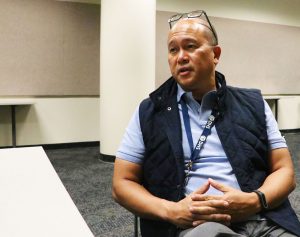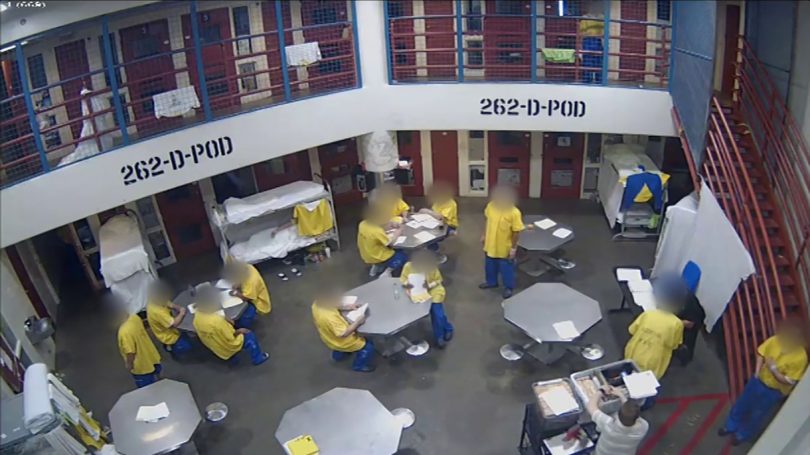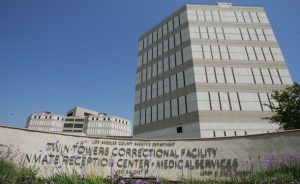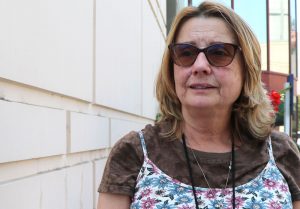“Welcome to the zoo,” said LA County Sheriff’s Deputy Jacob Allen, motioning to the figures behind him wearing bright-colored jumpsuits stamped with the words LA COUNTY JAIL. The men are separated from Allen and other guards by a thick glass wall. In addition, each inmate is behind a locked metal door, with the exception of a tall, bearded man standing chained to a wall in the center of the room. His brown eyes look glassy and dull.
This is module 142 at Twin Towers Correctional Facility, located one mile north and east of Los Angeles City Hall. The inmates in this section of the jail can only come out of their cells individually for an hour at a time. There is a yellow line on the floor to indicate the path inmates must take when they are out of their cells. During this time, they wear a waist chain and their hands are cuffed.
Behind the glass are desks and chairs, where guards monitor the men’s behavior and dispense meals and medication. The yellow line cuts through this room to others containing such amenities as a refrigerator and lockers for the guards, a large patio with a basketball hoop, which inmates can sometimes use, and private areas for therapy and legal appointments.
Although the population in California jails, in general, has dropped over the last ten years, the proportion of those suffering from mental illness in those same jails rose 63 percent between 2009 and 2019. In LA County’s jails, as of June 2019, there were 5,544 people who were either held in mental health housing units, taking psychotropic medications or both — or about 30 percent of the county’s total jail population.
Twin Towers, which has a history peppered with inmate abuse and neglect, is where most of the system’s mentally ill are housed and is considered the nation’s largest mental health facility. Despite several large lawsuits, followed by two major settlement agreements intended to improve conditions inside the place, Twin Towers has consistently failed to meet some of the basic requirements for inmate care.
The jail is made up of two main “tower” buildings and the adjacent Correctional Treatment Center (CTC), which houses the mental health cases with the most serious problems. Justiniano Jaojoco, the Nurse Manager at CTC, said that understaffing and inadequate resources make it difficult to provide inmates with the care they need.

Justiniano Jaojoco, the nurse manager for Correctional Treatment Center in Twin Towers/Katherine Tangalakis-Lippert
“If we had more staff and more supervision we could take them out [of their cells] more,” Jaojoco said. “Meds could be delivered a little better, faster.” There would be “less arguing with the patients.”
When the staff is short causing a delay in getting the medication to the men, patients become agitated, he said. “Before you reach that patient,” things are “already out of control.”
This is true, according to Jaojoco, even after the improvements forced by the lawsuits and the settlements.
Prominent among these legal deals is the 2015 Department of Justice settlement agreement with LA County and the Los Angeles County Sheriff, citing inadequate mental health protocols, failure to protect prisoners from serious suicide risks, and excessive use of force.
The agreement mandated a series of reforms within the county’s correctional facilities in order to make sure the jails, particularly Twin Towers, provided “constitutionally adequate care for prisoners with serious mental illness.” The DOJ agreement was—and still is— overseen by an independent monitor and enforced by a federal judge.
Yet, despite increased financial resources being delegated to the jail system as a result of the lawsuit, nearly five years later several critical conditions of the settlement are still not hitting the necessary marks.
Richard Drooyan, an LA-based attorney, who has served on a string of high profile law enforcement reform panels, is in charge of monitoring the terms of the federal settlement. He said the biggest concern is the lack of out-of-cell time for inmates.
The jails, Drooyan said, “just haven’t been able to meet the number of [out of cell] hours required under the settlement agreement for inmates in the mental health housing,”
Specifically, the text of the settlement stipulates “ten hours of unstructured out-of-cell recreational time and ten hours of structured therapeutic or programmatic time per week.” Minimum.
As of his most recent report in August 2019, Drooyan said, Twin Towers remains noncompliant with both these basic requirements. (An updated report will be released from his office later this month.)
The effect of solitary confinement and isolation on incarcerated people has proven to have a long-term impact on their mental health. Extended periods of isolation can cause depression and psychosis symptoms in people who have never experienced mental illness before. For those with pre-existing mental health conditions, isolation exacerbates their symptoms and significantly increases the risk of suicide.
Drooyan said the shortage of out of cell time also affects the inmates’ ability to access individual and group therapeutic services.
Jaojoco agreed that, as it stands, too often inmates don’t get access to the most basic resources they need.
Many of the inadequacies can be tied to lack of staff and insufficient staff training, said Jaojoco.
A chronic and well-documented shortage of LASD deputies has impacted the Sheriff’s department for quite some time, affecting the number of deputies in some of the department’s “contract cities,” in unincorporated areas of LA County, and reportedly also in the county’s jails. Although Sheriff Alex Villanueva has been energetically recruiting, the still low numbers also mean there are fewer deputies inside with the specialized training needed to work effectively with mentally ill inmates, according to both Drooyan, and staff members like Jaojoco.
“We haven’t had sufficient staff for the past few years,” Jaojoco said.
Working ‘inside’
“These are the crazies,” Deputy Ralph Sanders said as he walked past the men in module 172. On the heavy doors of each cell, one sees labels: “spitter,” “gasser” and “extremely violent.”
For those unfamiliar, gassing is a slang term for throwing feces or bodily fluids such as urine or semen at deputies or fellow inmates. While often a symptom of untreated mental illness or the result of mental stress due to conditions of incarceration, the act can also result in additional felony charges and more time inside.
Sanders has been working as a correctional officer at Twin Towers for four years. He also has six years of experience as a U.S. Marine and still keeps his light hair cropped short and speaks in brief, curt sentences. Sanders’ general approach to his job in the jail shows remnants of his time in the military.
The floor where Sanders works is the first stop for those who are locked-up at Twin Towers. There, inmates are supposed to be given a psychiatric evaluation by a clinician, either a psychiatrist or nurse, within 24 hours. When the men arrive, they are stripped and given rip-proof gowns to wear while they wait so they cannot create a noose out of their clothing.
“With a normal person, you can just go up and talk to them. With these guys, you just never know. We’re lucky if they have clothes on,” Sanders said.
Deputies often have little idea about the mental or emotional states of the inmates they are meant to oversee. For reasons of medical privacy, the guards are given no specific information about inmates’ physical and mental conditions unless someone has expressed a desire to hurt himself or someone else.
Then, observation protocol is supposed to become rigorous and guards are required to check in on such inmates every 15 minutes.
“We’re not qualified at all for mental health situations. We just don’t have the training,” said Deputy Jose Flores. Flores has been working at Twin Towers for three years, after completing a degree in criminal justice.
Guards at Twin Towers are given just one 40-hour training dealing with mental health issues facing inmates. The training focuses mainly on de-escalation techniques through verbal cues, Flores and Sanders explained.
Nevertheless, Sanders and Flores speak about the struggles they encounter with such daily tasks as bringing mentally ill inmates out of their cells and readying them for transport to court, giving them their medications, and breaking up fights.
“It can be hard sometimes…” Sanders said.
Restraints and diversion
The advent of the DOJ settlement that Drooyan is overseeing, plus that of Rosas v. Baca (a major class-action lawsuit alleging extreme violence against inmates in LA County’s jails, which was settled in December 2014) precipitated a shift in the jails’ procedures and the system’s general culture. The department was forced specifically to address its history of inappropriately using restraints by implementing new standards of use, which first had to be cleared with the feds.
One method of inmate control, sometimes called tethering, involves binding a man or woman’s limbs tightly together with locking straitjackets or straps called hobbles. In past years, tethering has been cited in multiple reports of abuse where inmates were left alone, bound, sometimes naked, for many hours at a time – as in one 2015 case in at Twin Towers which resulted in a man’s death.
Jaojoco’s unit, in particular, he said, has made significant strides in the use of restraints on inmates. According to Jaojoco, CTC used to keep 30-40 patients per month in restraints. In the past year, restraints were only used on three patients.
Yet, despite some improvement, critical systemic problems such as staffing shortages and inadequate training have not gone away. These issues cannot help but create stressful work environments for those employed in the jails, and conditions that result in psychological harm, or worse, for those who are sentenced to Twin Towers.
With these problems in mind, the 2019-2020 budget for LA County allocated $93 million towards mental health services and diversion from the criminal justice system. Of that, $20 million has been budgeted toward additional treatment beds, $20 million for expanding supportive housing with the Office of Diversion and Reentry, and $53 million for increased support of diversion programs, which have been proven to be less expensive, less harmful, and far more effective than incarceration at reducing recidivism for those struggling with “behavioral health.”
In 2018, the Los Angeles County’s Board of Supervisors asked for a study of the existing mental health population in LA’s jails to identify those who would likely be eligible for diversion based on legal and clinical factors. The results of the study were released in January by the RAND Corporation and the news was generally good. Researchers found that an estimated 61 percent of the jails’ mental health population was likely appropriate for diversion. Another 7 percent was potentially appropriate.
Yet, this still left 32 percent who, according to RAND, were likely not appropriate candidates for diversion. A lot of those people will be sent to Twin Towers and subjected to its problems.
The revolving door
Getting people what they need for the transitional period from jail to life outside is also problematic, according to Mary Whaley, who oversees the jail release transition for inmates being treated for mental health.
“There are not enough resources,” Whaley said. “There just simply are not.”
After release, the jail system provides everyone with 30 days of medications and 90 days of services via what is known as the Community Transition Unit, through which the departments of Probation, Mental Health, and Public Health, theoretically help those leaving custody to connect with outside resources.
Unfortunately, a large number of those released from a mental health unit don’t access those services, or continue any kind of mental health treatment beyond 30 days, Whaley said. Too often, when someone struggling with mental illness is released, their first priority is food and shelter and everything else falls by the wayside, she said. It doesn’t help that many don’t have insurance and struggle to navigate the Department of Mental Health system to schedule follow-up appointments and refill their medications.
In addition, Whaley said, there aren’t enough community programs to assist with living arrangements and reintegration. Most of the programs she knows of are useful, she said, but supportive housing fills up fast and it can be a struggle to find placement for her most mentally ill clients.
“We’re supposed to find housing and resources for individuals and it’s just not out there,” Whaley said.
Whaley and Jaojoco both reported that some men and women actively try to return to jail because it is the only place where they have access to consistent medication and psychiatric services.
Outside, Whaley said, the most vulnerable often self medicate or commit petty crimes like loitering while naked, knowing they’ll be picked up and sent back to the Twin Towers.
“They say, ‘I’ll see you next time,’” Whaley said.
Although the LA County District Attorney’s office contends that they generally divert mentally ill people who commit such misdemeanors, many public defenders with mentally ill clients say otherwise.
Jaojoco does not paint a rosy picture either, referring to the LA County Jail system as a “revolving door” when it comes to many of those battling mental health issues.
And, for those who return, while they might get needed medication, Whaley and Jaojoco conceded that jail is not a place of healing.
“Jail will make you really sick,” Jaojoco said, his voice softening. “I would be sick here if I was on the other side.”
PostScript
Justice advocates, like those at Dignity & Power Now, and others who are behind Measure R, say that the conditions in Twin Towers are far worse than those who work there are admitting. They cite the 2018 deaths of Quinten Thomas and Lewis Nyarecha, who both died under questionable circumstances at Twin Towers, as evidence that LASD officials have not yet begun to adequately address basic inmate safety concerns.
(Measure R is a local ballot proposition that will be on the March 3 ballot and, if passed, will strengthen civilian oversight for the LA County Sheriff’s Department, and require the county to come up with a plan to use mental health treatment in order to lower the jail population.)
Reporter Katherine Tangalakis-Lippert is an investigative journalist living in Southern California with her retired service dog, Liberty. Through her work, Katherine aspires to help strengthen the fragile trust between journalists and the public. You can find her on social media as @scrawlgirl.
Sophie Bress and Rebecca Katz contributed to this story.
Top photo courtesy of LASD.






…..and why again did the LA County BOS scrap the plan for the Mental Health Treatment Center which was to be ran by the Department of Mental Health, staffed by medically trained orderlies and would be purpose built for the task?
It has to have been more than just ego and pettiness on the part of the BOS as a way to allegedly hurt and get back at the current Sheriff at the expense of what’s best for the mentally ill? I guess the BOS sure put the Sheriff in his place?
This article would have been more complete if it had addressed that issue as well.
“…On the part of the BOS as a way to…get back at the current Sheriff….”
Did you see the Measure “R” ads on T.V.
WOW!!!
Despite their best efforts, Deputies cannot ever replace a psychiatrist or other mental health professional, nor is it their job to do so. There’s more money and nicer working conditions in private practice for mental health professionals, so it’s very hard for DMH to hire for facilities, where the workload can be pretty thankless. The other grim reality is that there is no place for most of these people to live upon release. so they float back to the streets, start using again, lose or run out of their meds and within the blink of an eye are back. Jail is a lot nicer for some than life outside. It’s no way for them to live.
As usual, the Board keeps putting lipstick on a pig rather than dealing with the real needs. Take a cruise through Downtown LA (not at night) – the issues of mentally ill and homeless that impact the entire county are well illustrated.
You mean the one were the mother of the deceased laments the fact that her son died in jail but omitted the minor detail that it happened TEN YEARS AGO? Measure R has nothing to do with accountability, that was only delivered by the DOJ via the FBI. All throughout Banaka’s reign of terror, the BOS was too busy looking the other way. You have to admire the cunning deception awaiting the ignorant voter.
Notwithstanding the reporter’s poor choice of words (guard), she fails to connect the disconnect with Measure R supporters and reality. The MHTC proposal would have provided the resources to care for the mentally ill who will remain in the custody of LASD, and will never see the light of day outside of jail. So they blocked the one proposal that would alleviate the problem and then they complain about the problem not being alleviated. Welcome to the wacky world of Patrice Cullors, Dignity and Power Now, the BLM, and social justice warriors everywhere.
WHY would the Board support two projects (Mira Loma and MHTC) totaling almost 3 billion dollars when the Sheriff himself didn’t support it? He’s on record as saying he thought Miral Loma shouldn’t be opened, even though it HAD to be, as swing space for inmate movement when CJ was demolished. With mentally ill homeless literally shitting on HOJ’s stairs, he said in an interview that MHTC was “putting lipstick on a pig” and the project was “too soon,” (after YEARS of research, development and planning and MILLIONS of dollars).
Eventually his staff told him it was ESSENTIAL and that the mental health population was exploding. I guess he hadn’t noticed all the homeless around the Hall of Justice and the FIVE THOUSAND inmates in his jails that were gouging their own eyes out (really) and eating their own poop, when they weren’t throwing it at deputies.
It was Villanueva’s own comments that doomed the projects. He followed those comments up with really stupid actions (insulting the Board, questionable campaign donations, investigating the COC, Mandoyan, executive firings, super promotions, etc. etc.).
Yes, he appeared before the Board for a rambling, blithering, mumbling last ditch effort to save the projects, but it was WAY too little, too late. I’ve never been so embarrassed by a Sheriff’s performance before the Board in my career (and that INCLUDES Baca).
I now hear that the stable genius Sheriff has ordered County Counsel out of HOJ…..REALLY. Apparently his top people didn’t bother to tell him it’s a COUNTY building, not a Sheriff’s building. With each misstep, I think more and more of this scene from “Downfall” (skip to 0:40):
https://www.youtube.com/watch?v=pR5q0ajW8Ko
LASD Apostle….I thought when the BOS held the meeting for the proposed MHTC it deliberately excluded then new Sheriff AV or any LASD representstives? My thoughts were, the BOS was sending a message that it wanted to go in a different direction and not give the new Sheriff a new jail (it’s not for him but for the taxpayers). The Sheriff at this point of probably felt “I have no dog in this fight” since they did not include LASD in any of the planning stages once the BOS decided DHS would be in charge of the MHTC. I do wonder how DHS would have handled security issues insude the new facility….private security I guess.
This was a huge mistake by the BOS, one of many, they will never be held accountable for. Who ultimately did the BOS really hurt in the their efforts to get back at the Sheriff?
“You mean the one…that…HAPPENED TEN YEARS AGO?”
Yep, that one.
The public will see it on the evening news & AV will get demonized in the public mind, which is the intent of the BOS.
The election is not far away & this ad will be taken off the air after March 3, so hurry up & tune in if you want to see it.
A precursor, though, of things to come from the BOS during the remainder of AV’s term.
Nothing like revisionist history to prop up a losing argument. You sound like one of those wannabe empire builders that didn’t get their way, so sad. Apparently you’re one of those idiots who think the board runs the sheriffs department, not the sheriff.
I find it curious you keep harping on one board hearing that was decided before it started, yet can’t seem to wrap your mind around all the good things the sheriff is doing. He’s racking up the earned media on a daily basis, much to your chagrin.
Crime is down, jail violence is down, morale and hiring are off the charts, and all you can do is snivel in anonymity. Love it!
Yeah, 10-4 partner. Try tie our sheriff to a ten year old death in custody. You suffer from some derangement syndrome.
Comparing AV to Hitler is a bit much; remember, he’s a graduate of the Army’s Officer Candidate School (National Guard version), so he can turn things around.
If he can introspectively get his shit together.
I certainly hope AV has more than just the rank insignia stunt up his sleeve in the leadership department.
Sheriff V has done something no sheriff has done since Pitchess days, which is to hold management accountable. Shocking for some who are used to the days of failing upwards, but long overdue. Definitely not a “stunt,” LOL.
BTW, the only ones who seem to have taken exception to that exercise are the very people who probably shouldn’t have been promoted in the first place.
Wow! looks very true. Just like old days.
Cognistator – Not if he is guided by Rasputin
Conspiracy, there were several meetings of the BOS regarding CCTF (later renamed MHTC) and Mira Loma. The death of both projects wasn’t the result of JUST AV’s statements and actions, it was a perfect storm of public anti-cop sentiment, a small but vocal anti-jail movement and an ever increasing chorus of liberals believing that most offenders could be released into the public and needed treatment instead of incarceration…enter bail “reform,” criminal justice “reform,” and “diversion.”
AV was aware of this change in public sentiment and, of course, came out against these expensive (but badly needed) projects to get elected. Once the former shift watch commander became Sheriff and had the big picture explained to him with current and projected mentally ill inmate numbers, he realized he needed to back the projects. Of course, by then he’d already irreparably damaged his relationship with the BOS who were also feeling intense pressure from a small, liberal and loud group to NOT build anything that even smelled like a jail.
Mark my words, some iteration of these projects WILL be built in LA County and the eventual cost will dwarf the cost of MHTC and Mira Loma. That one move by AV, which was the death knell for the projects, will cost LA County taxpayers MANY billions of dollars in the future.
In other news…..what’s happening at Malibu Station? First a lawsuit by a white female lieutenant who SHOULD have been captain and now the removal of the captain. The next captain will be a tough choice for AV, he only wants males in charge of patrol stations and he’s not big on non-Latinos. Let’s see who gets picked.
Keep Dreaming,
It most certainly was a stunt. It was a demeaning and insulting thing to do to men and women who far out shined AV during their careers in management-level positions that he never had. AV’s election does not somehow bestow any amount of experience or knowledge he didn’t gain as a watch commander. This has become very evident in his expensive stunt involving Mandoyan. Even a deputy who worked IAB could have told him he was not doing the right thing, logistically or legally.
I still wish AV well in his position – nobody associated with LASD wants anything but the best for it and its people. Treating his execs like they were so many rungs below him (just deputies in his own words) demonstrates a lack of respect for those he should be depending on to compensate for his lack of experience. Piss and moan about who should and shouldn’t have been promoted, but the fact is they were promoted and gained a great deal of wisdom and experience in multiple facets of the job, which AV needs to trust and tap into.
NOTHING has changed!! No hot water, Rx deprivation, cleanliness, no tp. Crappy commissary! ACLU has lawsuit after lawsuit against the LASD and contempt charge on Sheriff Luna! I wish a reporter would respond to me!!